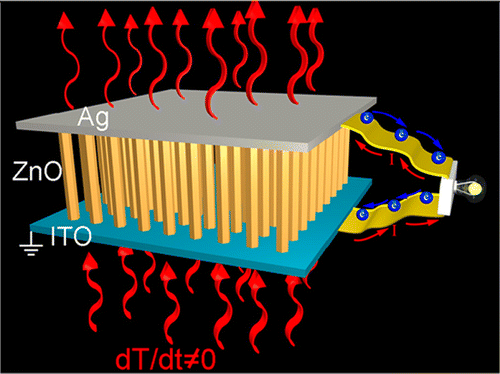Ancient effect harnessed to produce electricity from waste heat

A phenomenon first observed by an ancient Greek philosopher 2,300 years ago has become the basis for a new device designed to harvest the enormous amounts of energy wasted as heat each year to produce electricity. The first-of-its-kind "pyroelectric nanogenerator" is the topic of a report in ACS' journal Nano Letters.
Zhong Lin Wang and colleagues at Georgia Tech explain that more than 50 percent of the energy generated in the U.S. each year goes to waste, much of it as heat released to the environment by everything from computers to cars to long-distance electric transmission lines. Heat can be converted to electricity using something called the pyroelectric effect, first described by the Greek philosopher Theophrastus in 314 B.C., when he noticed the gemstone tourmaline produced static electricity and attracted bits of straw when heated. Heating and cooling rearrange the molecular structure of certain materials, including tourmaline, and create an imbalance of electrons that generates an electric current. Wang's group wanted to apply the ancient principle to make a nanogenerator (NG) that could take advantage of heat changes in the modern world, which uses a time-dependent temperature change to generate electricity.
To do that, the researchers made nanowires out of zinc oxide, a compound added to paints, plastics, electronics and even food. Using an array of short lengths of nanowire standing on end, they demonstrated a device that produces electricity when heated or cooled. They suggest the nanogenerators could even produce power as temperatures fluctuate from day to night. "This new type of NG can be the basis for self-powered nanotechnology that harvests thermal energy from the time-dependent temperature fluctuation in our environment for applications such as wireless sensors, temperature imaging, medical diagnostics and personal microelectronics," the authors said.
More information: “Pyroelectric Nanogenerators for Harvesting Thermoelectric Energy” Nano Lett., 2012, 12 (6), pp 2833–2838. DOI: 10.1021/nl3003039
Abstract
Harvesting thermoelectric energy mainly relies on the Seebeck effect that utilizes a temperature difference between two ends of the device for driving the diffusion of charge carriers. However, in an environment that the temperature is spatially uniform without a gradient, the pyroelectric effect has to be the choice, which is based on the spontaneous polarization in certain anisotropic solids due to a time-dependent temperature variation. Using this effect, we experimentally demonstrate the first application of pyroelectric ZnO nanowire arrays for converting heat energy into electricity. The coupling of the pyroelectric and semiconducting properties in ZnO creates a polarization electric field and charge separation along the ZnO nanowire as a result of the time-dependent change in temperature. The fabricated nanogenerator has a good stability, and the characteristic coefficient of heat flow conversion into electricity is estimated to be 0.05–0.08 Vm2/W. Our study has the potential of using pyroelectric nanowires to convert wasted energy into electricity for powering nanodevices.
Journal information: Nano Letters
Provided by American Chemical Society

















